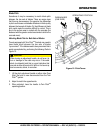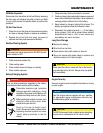
PAGE 28 — HHXD5 RIDE-ON TROWEL • OPERATION MANUAL — REV. #2 (05/04/12)
MAINTENANCE
Oil/Water Separator
Drain water from the bottom of the fuel filter by loosening
the drain plug and allowing the water to drain out. Refer
to your engine manual for specific details to perform this
operation.
Oil And Fuel Lines
1. Check the oil and fuel lines and connections regularly
for leaks or damage. Repair or replace as necessary.
2. Replace the oil and fuel lines every two years to
maintain the line's performance and flexibility.
Radiator/Cooling System
1. Check and clean radiator fins.
2. Check cooling water.
3. Check radiator hoses for fatigue or cracking.
4. Check radiator cap seal.
Battery/Charging System
WARNING
Hot coolant can cause severe burns. DO NOT remove
cap if radiator is HOT.
1. Check and clean battery terminals for corrosion.
2. Check and keep battery electrolyte between upper and
lower limits indicated on the battery. Never operate or
recharge without sufficient fluid in the battery.
3. Never attempt to charge a battery that is frozen. The
battery can explode unless first allowed to thaw.
4. Disconnect the negative terminal ( - ) of the battery
during storage. If unit will be stored where ambient
temperature will drop to -15
o
C or less, remove and
store battery in a warm, dry place.
Long Term Storage
Remove the battery.
Drain fuel from fuel tank.
Clean exterior with a cloth soaked in clean oil.
Store unit covered with plastic sheet in moisture and
dust-free location out of direct sunlight.
Engine Tune-Up
See your engine manual for specific information on tuning
up your engine.
CAUTION
Never store the ride-on trowel with fuel in the tank for
any extended period of time. Always clean up spilled
fuel immediately.
NOTICE
See the engine manual supplied with your machine
for appropriate engine maintenance schedule and
troubleshooting guide for problems.
CAUTION
ALWAYS disconnect battery cables before attempting
any service or maintenance on the ride-on trowel.
DANGER
Use all safety precautions specified by the battery
manufacturer when working with the battery.
Flammable, explosive gas. (produces
hydrogen gas while charging or during
operation). Keep area around battery well
ventilated and keep from any fire source.
Battery electrolyte contains corrosive, toxic
chemical. (dilute sulfuric acid). Avoid
contact with eyes and skin.
Shock or Fire due to electric short-
circuit. Disconnect battery cables before
inspecting electrical system and never
"spark" battery terminals to test for
charge.


















